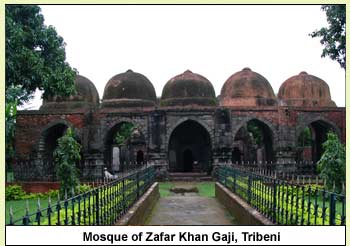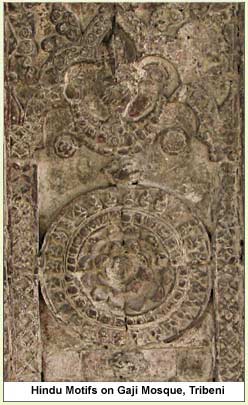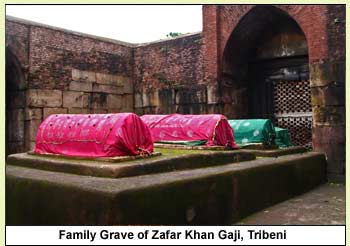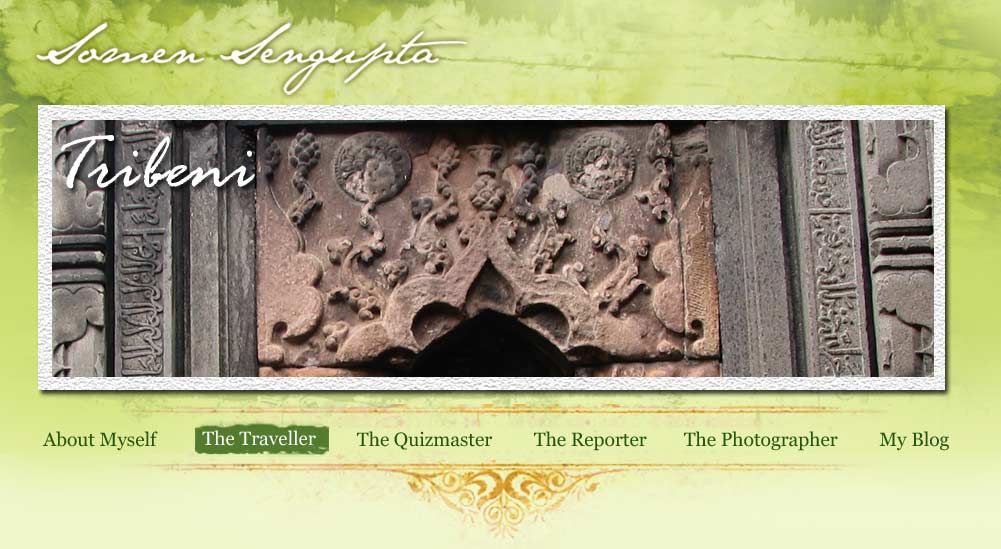| Tribeni is home to one of the architectural landmarks of Bengal ? its oldest mosque. That and the many small wonders surrounding it make this small town in Hooghly an ideal destination for a weekend trip. According to Hindu mythology, Vishwakarma had taken up the challenge to build a second Benaras here, but Lord Shiva scuttled his plans. The master builder moved on, leaving his tools in Tribeni.

The town boasts of a rich heritage. In ancient times, the Hindu rulers had set up a river port here, at Saptagram. It flourished as a commercial hub.Tribeni also became famous for its Sanskrit scholars and temples. It was given the name Tirtharaj to highlight its importance to the pilgrims.The Benimadhab temple of Tribeni once used to attract as many pilgrims during Makar Sankranti as Allahabad. The royal family of Orissa built the ghats here.
Another myth surrounding Tribeni is that Ganga, Yamuna and Saraswati once converged here. While historians are still splitting hair over the existence of the Saraswati, the Yamuna is no wider than a canal now. The Ganga, though, retains some of its former glory.The newly-constructed Ishwar Gupta Setu offers a majestic view of the river.
I n 1298, Zafar Khan Gaji attacked the Saptagram port and vanquished the Hindu king Dharma Pal. Legend has it that Gaji destroyed several temples and killed most Hindus in the area. He then proceeded to build a massive mosque with the debris of the temples. The mosque, made of black basalt, is the oldest in Bengal. Some historians are sceptical about the apocryphal account. The Cambridge History of India (Part III) however maintains that the building material of the mosque came from a Krishna temple which ?formerly stood on the same spot but is now so mutilated as to have lost most of its architectural value. n 1298, Zafar Khan Gaji attacked the Saptagram port and vanquished the Hindu king Dharma Pal. Legend has it that Gaji destroyed several temples and killed most Hindus in the area. He then proceeded to build a massive mosque with the debris of the temples. The mosque, made of black basalt, is the oldest in Bengal. Some historians are sceptical about the apocryphal account. The Cambridge History of India (Part III) however maintains that the building material of the mosque came from a Krishna temple which ?formerly stood on the same spot but is now so mutilated as to have lost most of its architectural value.
An Archaeological Survey of India excavation unearthed statues of Vishnu and Krishna from the site. The figures are of various periods and styles, hence the age of the destroyed temple cannot be ascertained. A tour of the mosque will perplex a first-time visitor as there are innumerable motifs and statues of Hindu gods and goddesses on the walls. Plaques in Sanskrit are also carved on the stones. The statues of Lord Vishnu holding a mace are distorted and defaced. Historian Jadunath Sarkar has described the mosque as a museum of Muslim epigraphy. A portion of the mosque houses the grave of Gaji's third son and his grandsons. There is a fourth grave of an unknown woman. On the eastern side are the graves of Gaji and his two elder sons. Gaji's wife, a Hindu princess, is also buried here.
Interestingly, Hindu deities are sculpted on the backs of the headstones. Hindu motifs like lotus and conch shells adorn the doors to the graves. Statues of Narasimha, Baraha, Rama, Krishna and Lakshmi can be found on the northern side of the mosque. All statues on the southern side are defaced. D. Moni, after extensive research on the mosque, had concluded that the walls once had panels depicting scenes from the Ramayana and the Mahabharata. Historian Rakhal Das Banerjee supported the claim.
The mosque looks more like a temple from outside. There is a theory that Gaji was buried in its garbha griha in 1313 after being killed in a war.
The tombs and arches offer a glimpse of the Islamic style of architecture. Statues of Buddha and Jain saint Paraswanath can also be seen.
Seven Shiva temples, built by Chakumar Singh in 1841, though simple, are worth a visit. The shivlings have been named as Benimadhab, Sashishekhar, Vishweshwar, Rameshwar, Yogeshwar, Gangadhar and Chandishwar.
Going:
Tribeni is 48 km from Calcutta by rail. It is the station after Bansberia. The journey takes around an hour-and-a-half by local train. The town is hardly two hours by road, along Kalyani Expressway. You can also go via Bandel.
Staying:
Try to return by evening. There is a dearth of good restaurants. Snacks, sweets and mineral water, however, are readily available. Stop over at the Hangsheswari temple in Bansberia if you can |



